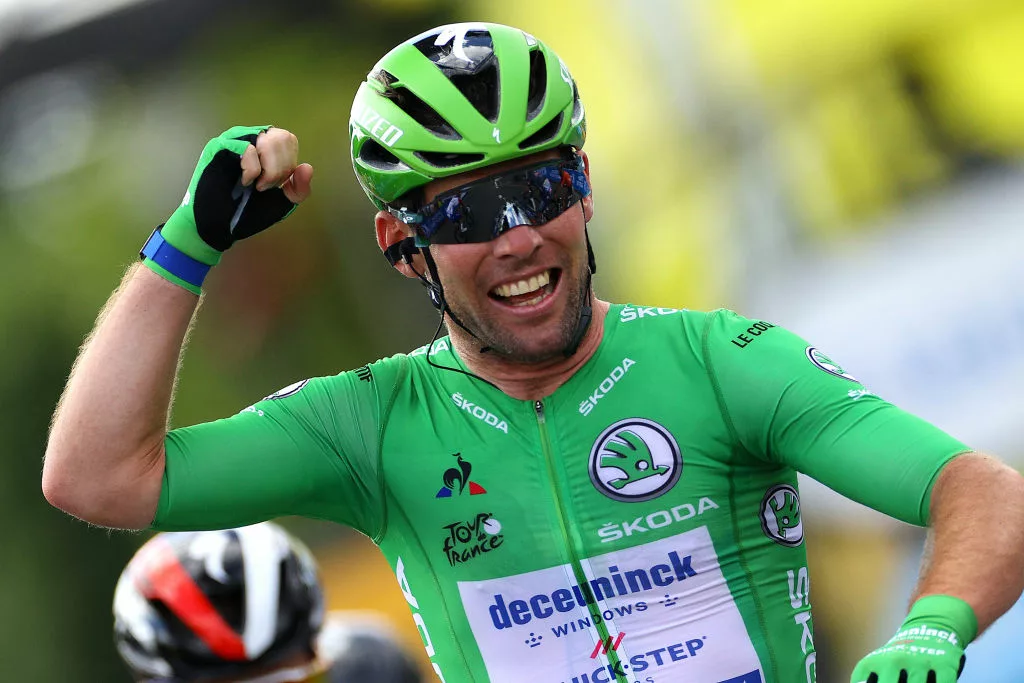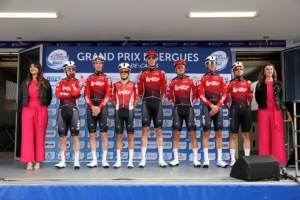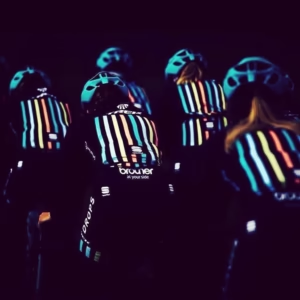The Tour de France Green Jersey, known as the “maillot vert,” is awarded to the leader of the points classification in the Tour de France. Introduced in 1953 to celebrate the 50th anniversary of the race, this jersey has become a symbol of sprinting excellence, rewarding consistency, speed, and tactical prowess. Initially sponsored by a lawnmower company, hence its green colour, the jersey quickly became an iconic symbol of the Tour. It is one of the most sought-after prizes in cycling, second only to the iconic yellow jersey.
Table of Contents
ToggleWhat is the Green Jersey?
The green jersey is awarded to the rider who accumulates the most points during the Tour de France. Points are earned through high placements in stage finishes and intermediate sprints. Flat stages offer the most points, making sprinters the primary contenders for the green jersey. The competition often features intense rivalry, as riders must balance speed, endurance, and strategic placement throughout the race.
How Points Are Awarded
Points are given at stage finishes and intermediate sprints. Currently, the stage winner on a flat stage gets 50 points, while each intermediate sprint winner earns 20 points. Fewer points are awarded on hilly and mountain stages, so sprinters have the best chance of winning the points classification.
| Position | Road Stages Without Any Particular Difficulties | Road Stages With a Rolling Profile | Road Stages With a Very Difficult Profile | Individual Time Trial Stage |
|---|---|---|---|---|
| 1 | 50 | 30 | 20 | 20 |
| 2 | 30 | 25 | 17 | 17 |
| 3 | 20 | 22 | 15 | 15 |
| 4 | 18 | 19 | 13 | 13 |
| 5 | 16 | 17 | 11 | 11 |
| 6 | 14 | 15 | 10 | 10 |
| 7 | 12 | 13 | 9 | 9 |
| 8 | 10 | 11 | 8 | 8 |
| 9 | 8 | 9 | 7 | 7 |
| 10 | 7 | 7 | 6 | 6 |
| 11 | 6 | 6 | 5 | 5 |
| 12 | 5 | 5 | 4 | 4 |
| 13 | 4 | 4 | 3 | 3 |
| 14 | 3 | 3 | 2 | 2 |
| 15 | 2 | 2 | 1 | 1 |
Tactics and Challenges
Joining a breakaway can help competitors gain an upper hand for the green jersey by reaching intermediate sprints ahead of their rivals. However, this tactic demands climbing skills and strong recovery abilities, which not all sprinters have. Therefore, the green jersey winner must be a well-rounded rider, not just the fastest sprinter. To win the green jersey, the rider must complete all 21 stages of the Tour de France. This includes crossing the highest mountains within the time limit and recovering well between stages.
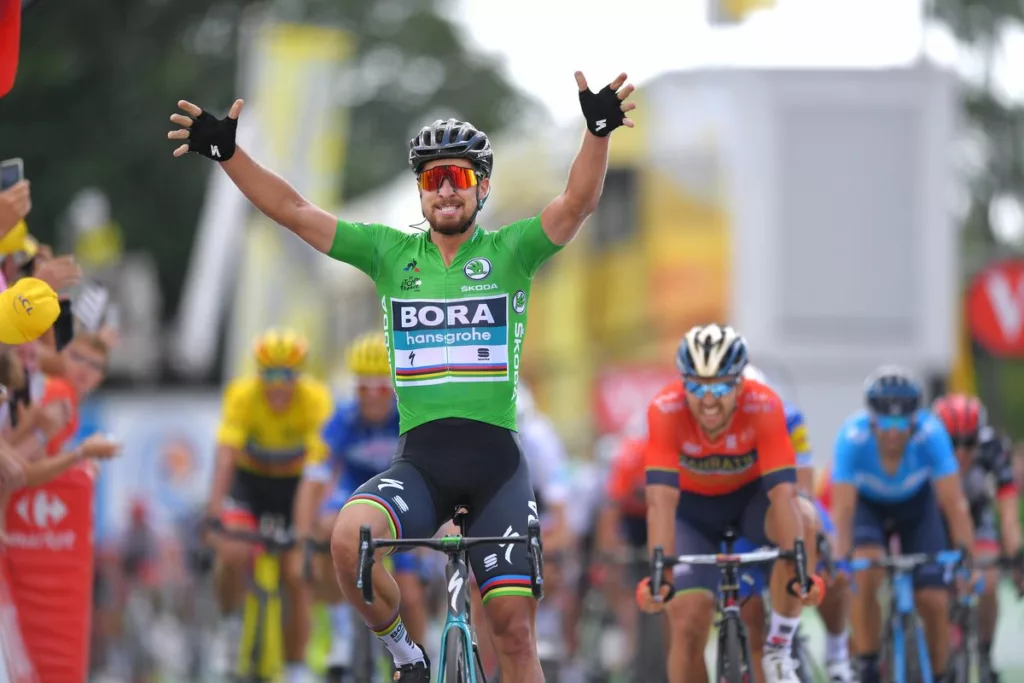
Who Has Won the Tour de France Green Jersey the Most Times?
Peter Sagan holds the record for the most green jersey victories. The Slovakian sprinter and all-rounder has claimed the maillot vert seven times (2012-2016, 2018-2019). Sagan’s remarkable consistency, versatility across various terrains, and sprinting prowess have solidified his place in Tour de France history.
Sagan’s achievements in the Tour de France are not limited to his green jersey wins. He has also secured 12 stage victories, showcasing his sprinting ability and tactical acumen. Notable stage wins include:
- 2012: Stages 1, 3, and 6
- 2013: Stage 7
- 2016: Stages 2, 11, and 16
- 2017: Stage 3
- 2018: Stages 2, 5, and 13
- 2019: Stage 5
Peter Sagan’s Green Jersey Wins:
- 2012: 421 points
- 2013: 409 points
- 2014: 431 points
- 2015: 432 points
- 2016: 470 points
- 2018: 477 points
- 2019: 316 points
Sagan’s ability to consistently finish stages in top positions has contributed to his repeated success in the points classification.
Which Rider Has Spent the Most Days in the Tour de France Green Jersey?
Peter Sagan has also spent the most days in the green jersey, wearing it for a total of 130 days through the 2020 Tour de France. This surpasses Erik Zabel, who wore the green jersey for 89 days. Zabel’s dominance in the points classification during the late 1990s and early 2000s is still highly regarded, with six consecutive green jersey wins from 1996 to 2001.
Notable Past Tour de France Green Jersey Winners
Sean Kelly: The Consistent Champion
Sean Kelly, an Irish cycling legend, is one of the most distinguished riders to have donned the green jersey. Kelly won the points classification four times during his illustrious career: in 1982, 1983, 1985, and 1989. Known for his all-around capabilities, Kelly was not just a sprinter but a versatile rider who excelled across different terrains and stages.
- Tour de France Stage Wins: Kelly secured five stage wins throughout his Tour de France career. His victories were spread out, showcasing his longevity and consistency in the sport.
- 1980: 1 stage win
- 1982: 1 stage win
- 1983: 1 stage win
- 1984: 1 stage win
- 1985: 1 stage win
- Green Jersey Victories: Kelly’s points classification wins in 1982, 1983, 1985, and 1989 highlighted his ability to maintain top performance across multiple editions of the Tour.
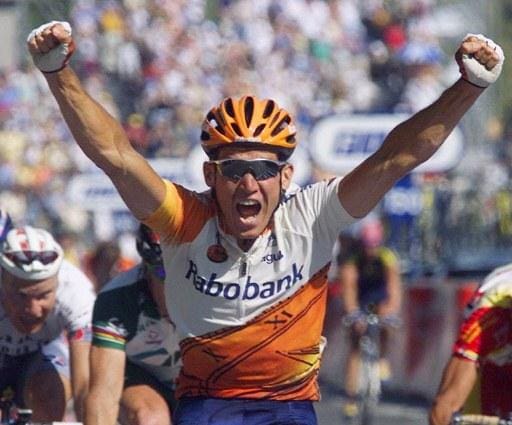
Robbie McEwen: The Explosive Sprinter
Robbie McEwen, an Australian sprinting sensation, claimed the green jersey three times (2002, 2004, 2006). McEwen’s sprinting style was characterised by his explosive speed and sharp tactical instincts, particularly in the chaotic final meters of a sprint finish.
- Tour de France Stage Wins: McEwen amassed a total of 12 stage wins during his Tour de France career, demonstrating his dominance in sprints.
- 1999: 2 stage wins
- 2002: 3 stage wins
- 2004: 1 stage win
- 2005: 3 stage wins
- 2006: 3 stage wins
- Green Jersey Victories: McEwen’s consistent performance in 2002, 2004, and 2006 earned him the green jersey, underscoring his tactical brilliance and sprinting excellence.
Mark Cavendish: The Manx Missile
Mark Cavendish, often hailed as one of the greatest sprinters in cycling history, won the green jersey in 2011. The British sprinter’s career is marked by his powerful finishes and an impressive number of stage wins in the Tour de France.
- Tour de France Stage Wins: Cavendish has achieved a staggering 34 stage wins in the Tour de France, equalling the all-time record held by Eddy Merckx.
- 2008: 4 stage wins
- 2009: 6 stage wins
- 2010: 5 stage wins
- 2011: 5 stage wins
- 2012: 3 stage wins
- 2013: 2 stage wins
- 2015: 1 stage win
- 2016: 4 stage wins
- 2021: 4 stage wins
- Green Jersey Victory: Cavendish’s green jersey win in 2011 was a result of his remarkable consistency and sprinting prowess throughout that year’s Tour.
Erik Zabel: The Record Holder
Erik Zabel, a German sprinting powerhouse, holds the record for the most green jerseys won in the Tour de France. Zabel claimed the points classification six times consecutively from 1996 to 2001, showcasing his unparalleled dominance in the sprints.
- Tour de France Stage Wins: Zabel’s career includes 12 stage wins in the Tour de France, highlighting his consistent success in the race.
- 1995: 1 stage win
- 1996: 2 stage wins
- 1997: 3 stage wins
- 1998: 2 stage wins
- 1999: 1 stage win
- 2000: 1 stage win
- 2001: 1 stage win
- Green Jersey Victories: Zabel’s six consecutive green jerseys from 1996 to 2001 are a testament to his sustained excellence and ability to outperform his rivals over multiple seasons.
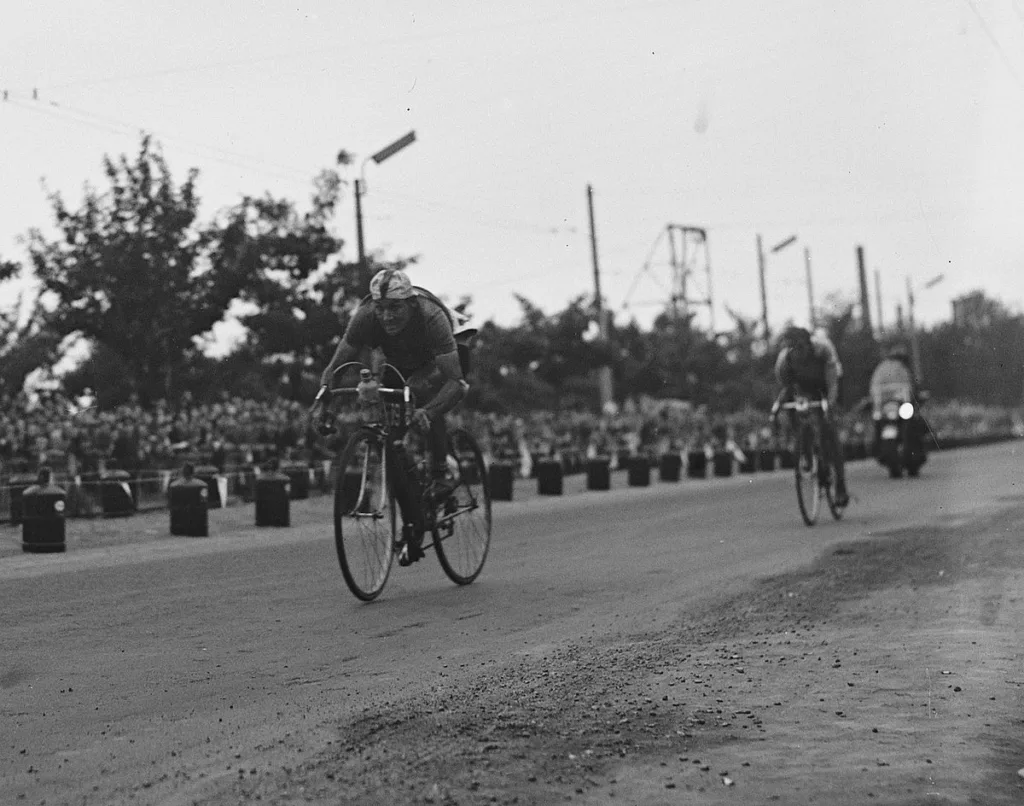
History of the Tour de France Green Jersey
The Inaugural Winner: Fritz Schär
Swiss rider Fritz Schär had the honour of being the first cyclist to don the green jersey. Schär’s victory in the points classification during the 1953 Tour de France was notable not only for its novelty but also for his exceptional performance. He demonstrated consistent speed and skill across various stages, ultimately securing third place in the overall general classification the following year, a feat rarely matched by modern green jersey winners who typically excel in sprints rather than overall endurance.
Early Points System
At the start of its life, the green jersey was awarded to the rider with the lowest points based on their total finishing positions throughout the Tour de France. This method focused on rewarding consistent high placements rather than outright stage victories. However, in 1959, the system underwent a significant change, transitioning to a format more recognisable today. Points began to be awarded based on stage finishes and intermediate sprints, thus encouraging aggressive racing and stage-winning efforts.
A Brief Colour Change: The 1968 Red Jersey
In a notable departure from tradition, the green jersey was replaced with a red jersey for the 1968 Tour de France due to a change in sponsorship. This switch created a unique visual shift in the peloton, with Italian cyclist Franco Bitossi emerging as the points classification leader that year. Bitossi’s prowess in stage finishes earned him the red jersey, but this alteration was short-lived.
Reversion to Tradition: The Return of the Green Jersey
The green jersey made its comeback in the 1969 Tour de France, reinstating its place in the race’s rich heritage. Since then, it has remained a staple of the competition, symbolising sprinting excellence and consistency across flat and intermediate stages. The green jersey has been worn by some of the sport’s most legendary sprinters, including Eddy Merckx, Sean Kelly, and Peter Sagan, each adding their legacy to the storied history of the points classification.
What Are Some Interesting Statistics About the Green Jersey?
- Most Points in a Single Tour: Peter Sagan holds the record for the most points accumulated in a single Tour, with 477 points in 2018. This record-breaking performance is particularly notable considering that Sagan was forced to withdraw from the 2017 Tour de France after a controversial disqualification. His comeback in 2018, with such a high points tally, shows his resilience and dominance in the sprinting field. To put this into perspective, Sagan’s 477 points were significantly higher than the second-place finisher in the points classification, clearly demonstrating his superiority that year.
- Youngest Winner: Eddy Planckaert, at 23 years and 8 months, became the youngest green jersey winner in 1988. Planckaert’s victory is remarkable not only because of his age but also because he achieved this during a highly competitive era for sprinters. At that time, the peloton included formidable sprinters like Sean Kelly and Eric Vanderaerden, making Planckaert’s triumph a notable feat of youthful talent against seasoned competitors.
- Oldest Winner: Erik Zabel claimed his sixth green jersey at the age of 32 in 2001. Zabel’s sixth win capped off a dominant period where he won the green jersey every year from 1996 to 2001. Zabel’s six victories also tie him with Sean Kelly for the most green jerseys won, highlighting his place among the legends of the sport. Interestingly, Zabel’s 2001 victory came in a Tour that saw him competing against emerging talents like Robbie McEwen, showcasing his enduring skill and competitive spirit.

Close Battles for the Green Jersey in Tour de France History
The green jersey, awarded to the leader of the points classification in the Tour de France, often results in some of the most intense and thrilling battles within the race. The competition for this jersey rewards consistency, sprint finishes, and tactical prowess across various stages. Here are some notable close contests:
1961: André Darrigade vs. Gérard Saint
- Margin: 5 points
- Overview: The 1961 Tour de France featured a tight contest for the green jersey between André Darrigade and Gérard Saint. Darrigade, a renowned French sprinter, faced stiff competition from his compatriot Saint, who was also vying for the prestigious points classification.
- Key Moments: The race saw both riders consistently scoring points, with Darrigade’s sprinting prowess giving him a slight edge. The competition remained fierce until the final stages, where Darrigade secured the green jersey by a narrow margin of 5 points, showing off the tight and competitive nature of the points race.
1970: Walter Godefroot vs. Eddy Merckx
- Margin: 5 points
- Overview: The 1970 Tour de France featured a close competition for the green jersey between Walter Godefroot and Eddy Merckx. Godefroot, a Belgian sprinter, faced off against Merckx, who was dominant in both the general classification and the points classification.
- Key Moments: The points race was tight throughout the Tour, with Godefroot leveraging his sprinting abilities to amass points in flat stages. Merckx, while primarily focused on the yellow jersey, also collected points with his versatile performance. Godefroot ultimately clinched the green jersey by a mere 5 points, demonstrating the narrow margins that can define this competition.

2001: Erik Zabel vs. Stuart O’Grady
- Margin: 8 points
- Overview: The 2001 Tour de France featured a tight race for the green jersey between Erik Zabel and Stuart O’Grady. Zabel, a dominant sprinter, was aiming for his sixth consecutive green jersey, while O’Grady posed a significant challenge with his strong performances.
- Key Moments: Throughout the race, Zabel and O’Grady exchanged the lead multiple times. The competition remained fierce until the final stages, where Zabel’s consistent performance in intermediate sprints and stage finishes allowed him to secure the green jersey by a slim margin of 8 points.
2003: Baden Cooke vs. Robbie McEwen
- Margin: 2 points
- Overview: The 2003 Tour de France witnessed an extremely tight race for the green jersey between two Australian sprinters, Baden Cooke and Robbie McEwen. This edition was particularly dramatic, with the lead for the green jersey changing multiple times throughout the race.
- Key Moments: The final decision came down to the last stage in Paris. Cooke managed to edge out McEwen by winning crucial points in the intermediate sprints and securing enough points in the final stage to win the jersey by a mere 2 points.

2009: Thor Hushovd vs. Mark Cavendish
- Margin: 10 points
- Overview: In 2009, Norwegian cyclist Thor Hushovd and British sprinter Mark Cavendish engaged in a fierce competition for the green jersey. Hushovd, known for his versatility and ability to collect points in various terrains, faced off against Cavendish, who was renowned for his sprinting dominance.
- Key Moments: Cavendish won an impressive six stages, showcasing his sprinting prowess. However, Hushovd’s strategy of consistently placing well in stages and collecting points in intermediate sprints, particularly in the mountain stages, allowed him to maintain a lead. Additionally, Cavendish was disqualified from earning points on one stage due to alleged dangerous riding, which further impacted the points tally.
2010: Alessandro Petacchi vs. Mark Cavendish
- Margin: 11 points
- Overview: The 2010 Tour de France saw Italian sprinter Alessandro Petacchi and Mark Cavendish locked in a close battle for the green jersey. Petacchi, a veteran sprinter, utilised his experience and consistency to challenge Cavendish, who was once again the fastest man in the peloton.
- Key Moments: Despite Cavendish winning five stages, Petacchi’s consistent high finishes and point accumulation in various stages, including those not typically favouring pure sprinters, enabled him to secure the green jersey.

